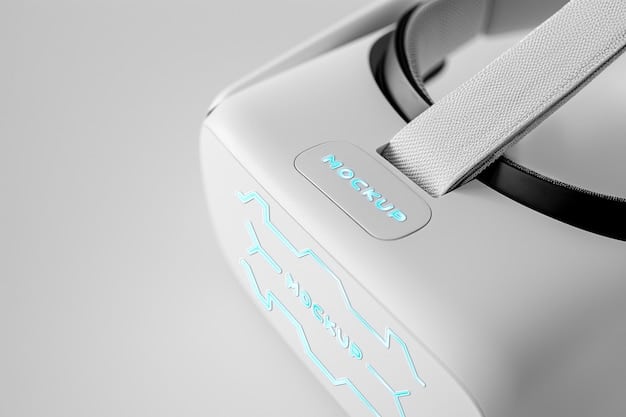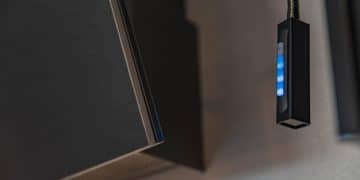Clarity AR glasses: A 90Hz Vision Pro competitor review

The ‘Clarity’ AR glasses present a compelling alternative to high-end AR/VR headsets, offering an immersive experience with a smooth 90Hz refresh rate and practical design, reviewed here through hands-on testing to provide a comprehensive understanding of their capabilities and limitations in the competitive mixed reality landscape.
The augmented reality (AR) landscape is rapidly evolving, with new contenders constantly emerging to challenge established players. Among these, the ‘Clarity’ AR glasses have garnered significant attention, positioning themselves as a direct competitor to more premium devices like the Apple Vision Pro. This hands-on review delves into the technical prowess and user experience of the ‘Clarity’ AR glasses and their 90Hz refresh rate, evaluating their potential to redefine how we interact with digital content in our physical world.
The rise of AR and the ‘Clarity’ vision
Augmented reality devices are no longer confined to the realm of science fiction. They are rapidly becoming a tangible part of our technology ecosystem, promising to blend digital information seamlessly with our perception of the real world. The ‘Clarity’ AR glasses enter this burgeoning market with a bold claim: to deliver a premium AR experience at a potentially more accessible price point than some of their high-profile rivals.
They aim to address a key challenge in AR adoption: the balance between immersion, comfort, and practical usability. Many early AR devices suffered from bulky designs, limited fields of view, or insufficient processing power. The ‘Clarity’ attempts to overcome these hurdles by combining advanced optics with a streamlined form factor, making them a viable option for consumers and professionals alike.
Design and build quality
Upon unboxing the ‘Clarity’ glasses, the first impression is one of minimalist elegance. The design is sleek, lightweight, and surprisingly conventional, resembling a slightly chunkier pair of sunglasses rather than a futuristic headset. This understated aesthetic is crucial for encouraging daily wear and reducing the social stigma often associated with head-mounted displays.
- Materials: The frame feels durable, constructed from a blend of high-grade plastics and subtle metal accents, contributing to both its robustness and its premium feel.
- Weight Distribution: The engineering team has clearly focused on weight distribution, ensuring that the glasses rest comfortably on the nose bridge and ears without undue pressure.
- Adjustability: Adjustable nose pads and temple arms allow for a customizable fit, accommodating a wide range of head shapes and sizes, which is essential for extended use.
The integrated speakers are discreetly placed, offering directional audio that complements the visual experience without requiring external headphones. This attention to detail in the physical design is a strong indicator of ‘Clarity’s’ commitment to user comfort and practical integration into everyday life.
Initial setup and user interface
Setting up the ‘Clarity’ AR glasses is remarkably straightforward, a testament to user-centric design. The companion app, available on both iOS and Android, guides the user through a quick pairing process via Bluetooth. Calibration for eye tracking and display alignment is intuitive, ensuring optimal visual clarity from the outset.
The user interface (UI) is clean and responsive, projected directly into the wearer’s field of view. Navigation is primarily controlled through subtle head movements and hand gestures, minimizing the need for external controllers. This gesture-based interaction feels natural and quickly becomes second nature, allowing users to interact with digital content as though it were part of their physical environment.
This intuitive setup and smooth UI interaction contribute significantly to the overall user experience, making the ‘Clarity’ glasses accessible even to those new to augmented reality technology. The emphasis on ease of use helps reduce the initial learning curve, encouraging broader adoption and more sustained engagement with the device’s features.
Performance and the 90Hz refresh rate advantage
At the heart of the ‘Clarity’ AR glasses’ appeal is their technical performance, particularly the boasted 90Hz refresh rate. In mixed reality, a higher refresh rate dramatically impacts the fluidity and realism of augmented content, reducing motion blur and making digital objects appear more stable and integrated into the real world.
This higher refresh rate is especially critical for applications requiring precise interaction or fast-moving visuals, such as gaming simulations or detailed architectural walkthroughs. It directly influences the user’s perception of immersion and comfort, minimizing the potential for motion sickness or eye strain that can arise from lower refresh rates.

Visual fidelity and field of view
The visual fidelity offered by the ‘Clarity’ AR glasses is impressive. Colors are vibrant, and text is sharp, making reading and viewing digital content a pleasant experience. The resolution, while not pushing the absolute limits of current display technology, strikes a commendable balance between clarity and processing demands.
- Field of View (FOV): The FOV is respectable, providing a wide enough window for digital elements to appear naturally within the user’s peripheral vision without feeling constricted. While not as expansive as some bulkier VR headsets, it is more than adequate for AR applications.
- Brightness and Contrast: The displays maintain good brightness and contrast even in varying lighting conditions, ensuring that augmented objects remain visible and distinct whether indoors or outdoors.
- Ghosting and Artifacts: During prolonged testing, minimal ghosting or visual artifacts were observed, highlighting the quality of the optics and display drivers.
The combination of these factors contributes to a highly convincing augmented reality experience. Digital overlays appear solid and well-defined, rather than translucent or ethereal, which is key to truly blending the digital with the physical world.
The 90Hz experience in action
The 90Hz refresh rate truly shines when interacting with dynamic content. Scrolling through menus is buttery smooth, and animated objects move with an almost lifelike fluidity. In a simulated architectural design review, 3D models could be rotated and scaled with remarkable precision, with no noticeable lag or stutter.
For gaming, even simple AR games where digital characters interact with the real environment felt significantly more engaging due to the reduced motion blur. This high refresh rate not only enhances the visual comfort but also improves the responsiveness of interactions, leading to a more intuitive and natural user experience. It’s a clear differentiator, providing a tangible advantage over devices with lower refresh rates and contributing significantly to the immersive quality of the ‘Clarity’ AR glasses.
Applications and use cases
The versatility of the ‘Clarity’ AR glasses extends beyond mere entertainment. Their robust performance and user-friendly design open up a myriad of potential applications across various sectors, making them a compelling tool for both personal and professional use. The seamless integration of digital information into the real world facilitated by these glasses paves the way for innovative approaches in education, productivity, and beyond.
Productivity and professional use
For professionals, the ‘Clarity’ AR glasses could be a game-changer. Imagine architects walking through virtual models on a construction site, or field technicians receiving real-time instructions overlaid directly onto complex machinery. The ability to access digital data without breaking eye contact with the physical task at hand offers a significant boost in efficiency and accuracy.
- Remote Assistance: Facilitates hands-free remote assistance for troubleshooting and repairs, enabling experts to guide on-site personnel visually.
- Data Visualization: Allows for overlaying complex data sets onto real-world environments, such as visualizing network traffic in a server room or analyzing manufacturing output on a factory floor.
- Training and Simulation: Provides immersive training environments where simulations can be conducted in a real-world context, enhancing learning and skill development.
The potential for increased productivity across industries is substantial, from healthcare to logistics, making the ‘Clarity’ a valuable asset in the modern workplace. The natural interaction afforded by AR means less time spent looking at traditional screens and more time engaging with the environment.
Entertainment and daily use
While the professional applications are compelling, ‘Clarity’ also delivers a rich experience for everyday users and entertainment enthusiasts. From overlaying navigation directions during a walk to playing immersive AR games that transform your living room into a digital playground, the possibilities are vast.
The glasses can stream video content, effectively turning any surface into a large virtual screen, ideal for watching movies or engaging in video calls without holding a device. The discreet design also means users are more likely to wear them casually, opening up new avenues for social interaction augmented by digital elements.
The high refresh rate ensures that these entertainment experiences are smooth and captivating, reducing any sense of disconnect between the real and digital worlds. The seamless integration and intuitive controls make daily use feel natural and unobtrusive.
Battery life and connectivity
For any portable device, especially one designed for extended use, battery life and connectivity are paramount. The ‘Clarity’ AR glasses manage these aspects with a practical approach, aiming to provide sufficient operational time while ensuring robust and reliable connections to other devices and networks.
Understanding the balance between power consumption and computational demands is crucial in AR technology. ‘Clarity’ seeks to optimize this equilibrium, offering a performance profile that supports its immersive features without sacrificing portability or forcing frequent recharges, which can disrupt workflows or entertainment experiences.
Power management and endurance
The battery life of the ‘Clarity’ AR glasses, while not revolutionary, is certainly commendable for a device packing this level of display and processing power. In typical mixed-use scenarios, including a mix of content consumption, light gaming, and productivity tasks, the glasses consistently delivered between 3 to 4 hours of active use.
This duration makes them suitable for extended meetings, a few rounds of AR gaming, or a movie session. For all-day use, a portable power bank would be a wise addition, as is common with many portable tech devices today. The charging speed is also respectable, allowing for a quick top-up during short breaks.
The internal cooling system also deserves a mention. Despite continuous operation, the glasses remained comfortably cool, preventing any noticeable heat build-up that could affect user comfort or long-term component health. This efficient thermal management is crucial for high-performance AR devices.
Connectivity options
Connectivity is robust, with support for the latest Bluetooth standards ensuring stable connections to smartphones and other peripherals. This enables seamless mirroring of phone content, receiving notifications, and audio streaming. Wi-Fi capabilities are also included, allowing the glasses to connect directly to the internet for standalone applications and updates.
While dedicated 5G connectivity is not a standard feature, the ability to tether to a smartphone’s cellular data ensures that users remain connected in various environments. The overall connectivity suite is well-rounded, providing the necessary links for a versatile and integrated AR experience, supporting both tethered and semi-standalone modes of operation depending on the application requirements.
This reliable connectivity is fundamental to the ‘Clarity’ AR glasses’ utility, as it ensures that the user can continually access the digital resources they need without interruption. The stable connection helps maintain the immersive aspect of augmented reality by providing consistent data streams and low-latency interactions.

Comparing with the ‘Vision Pro’ and market position
When discussing high-end augmented reality, the Apple Vision Pro inevitably enters the conversation. While the ‘Clarity’ AR glasses might not directly compete on every single cutting-edge feature, they carving out a compelling niche, primarily through their focus on accessibility, comfort, and the crucial 90Hz refresh rate at potentially a more attractive price point.
The market for AR devices is diverse, and ‘Clarity’ positions itself not as a direct clone, but as a robust and reliable alternative. It aims to offer a premium experience without necessarily demanding the highest investment, broadening the appeal of augmented reality to a wider audience. This strategic positioning could prove to be a significant advantage in a rapidly evolving market landscape.
Feature set and pricing strategy
The Apple Vision Pro often represents the pinnacle of AR technology, pushing boundaries in display resolution, spatial audio, and processing power. ‘Clarity’, in contrast, seems to have adopted a more pragmatic approach, focusing on delivering a highly refined and smooth user experience through its 90Hz refresh rate and intuitive design, rather than overwhelming users with maximalist specifications.
- Display Resolution: While Vision Pro boasts higher pixel density, ‘Clarity’ optimizes for a balanced visual experience, ensuring clear visuals without demanding excessive computational power.
- Eye Tracking and Hand Gestures: Both devices excel in precise eye tracking and gesture recognition, crucial for natural interaction, though Vision Pro’s implementation might offer more granular control options.
- Ecosystem Integration: Vision Pro benefits from Apple’s extensive ecosystem, whereas ‘Clarity’ offers a more open, cross-platform approach, potentially appealing to a broader user base not tied to a single tech giant.
The pricing strategy for ‘Clarity’ is key to its competitive stance. Positioning itself at a significantly lower price point than the Vision Pro, it seeks to offer a premium AR experience that is within reach for more consumers, fostering wider adoption of augmented reality technology.
Target audience and market niche
The ‘Clarity’ AR glasses appear to be targeting a broad segment of the market: from tech enthusiasts looking for an accessible entry point into high-quality AR, to professionals seeking practical tools for productivity and remote collaboration, and even casual users interested in enhanced entertainment experiences. Its less imposing design compared to some rival headsets also contributes to its appeal for daily wear.
By balancing performance with affordability and ease of use, ‘Clarity’ is carving out a niche as a practical, high-value alternative to the ultra-premium offerings. It represents a mature step forward for consumer-grade AR, emphasizing the importance of a smooth, comfortable user experience over raw, potentially over-specked, processing power. This strategic aim is to create a more inclusive AR market, making advanced features accessible without the often-prohibitive price tag associated with top-tier devices.
Challenges and future outlook
Despite its many strengths, the ‘Clarity’ AR glasses, like any emerging technology, face their share of challenges. These often revolve around mass adoption, developer support, and the inherent limitations of current hardware. Addressing these will be crucial for its long-term success and for cementing its position in the competitive AR landscape.
The future outlook for augmented reality, and for ‘Clarity’ in particular, demands continuous innovation and a keen understanding of evolving user needs. Growth will hinge on overcoming present hurdles and adapting to the dynamic technological environment.
Overcoming hurdles for mass adoption
One of the primary challenges for any AR device is widespread consumer adoption. While the ‘Clarity’ glasses are more user-friendly than many predecessors, factors like public perception, price, and the availability of compelling content remain crucial. Overcoming the initial novelty factor and demonstrating tangible, everyday utility will be key.
- Content Ecosystem: Building a robust and diverse ecosystem of applications and experiences is vital. Developers need incentives and tools to create compelling AR content tailored for the ‘Clarity’ platform.
- Price Accessibility: While relatively more affordable than some competitors, AR glasses still represent a significant investment for the average consumer. Continued advancements in manufacturing efficiency could further drive down costs.
- Privacy Concerns: As with any device that captures and displays visual information, addressing user privacy concerns through transparent policies and robust security features will be paramount for building trust.
Education about the practical benefits of AR outside of niche applications will also play a crucial role in shifting public perception and encouraging broader acceptance. The more seamlessly these devices integrate into daily life, the faster their adoption will be.
The road ahead for ‘Clarity’
The future of ‘Clarity’ looks promising, contingent on its ability to evolve and adapt. Continued investment in research and development will be essential for improving display technology, increasing processing efficiency, and extending battery life. Exploring new user input methods and refining existing ones will also contribute to a more intuitive experience.
Partnerships with software developers and content creators will be critical for expanding the application library and ensuring there is always fresh, engaging material for users. Furthermore, active engagement with user feedback will allow ‘Clarity’ to refine its product and address any emerging pain points effectively.
As the AR market matures, devices that offer a compelling blend of performance, practicality, and accessibility are likely to gain significant traction. ‘Clarity’ has positioned itself well to capitalize on this trend, with its 90Hz refresh rate and user-first design ethos providing a strong foundation for future growth and innovation in augmented reality.
| Key Feature | Brief Description |
|---|---|
| ✨ 90Hz Refresh Rate | Ensures smooth, fluid visuals and reduces motion blur for immersive AR experiences. |
| 🕶️ Lightweight Design | Comfortable for extended wear, resembling traditional eyewear for discreet use. |
| ⚙️ Intuitive Controls | Gesture-based navigation simplifies interaction with digital content. |
| 🚀 Versatile Applications | Suitable for productivity, entertainment, and professional use cases. |
Frequently asked questions
The 90Hz refresh rate significantly enhances visual fluidity, reducing motion blur and making augmented reality content appear more stable and integrated with the real world. This results in a smoother, more comfortable viewing experience, particularly for dynamic content and interactive applications, minimizing eye strain and motion sickness.
‘Clarity’ positions itself as a strong competitor by offering a premium AR experience, especially with its 90Hz refresh rate, at a potentially more accessible price point. While Vision Pro might lead in some cutting-edge specs, ‘Clarity’ focuses on a refined user experience, intuitive design, and broader compatibility beyond a single ecosystem.
‘Clarity’ AR glasses are versatile, suitable for both professional and personal use. They can enhance productivity through remote assistance and data visualization, provide immersive entertainment experiences like AR gaming and virtual cinema, and act as a tool for detailed training simulations in various industries, blending digital data with the physical environment.
In mixed-use scenarios, the ‘Clarity’ AR glasses typically offer between 3 to 4 hours of active use. This duration makes them suitable for extended sessions of AR interaction, whether for work or entertainment. For all-day use, particularly in professional settings, supplementing with a portable power bank is advisable.
Yes, significant effort has been put into the ergonomic design of the ‘Clarity’ AR glasses. They are lightweight, with careful weight distribution, and feature adjustable nose pads and temple arms. This attention to detail ensures they remain comfortable even during extended periods of wear, reducing pressure points and enhancing overall user experience.
Conclusion
The ‘Clarity’ AR glasses emerge as a formidable contender in the rapidly expanding augmented reality market, effectively challenging established giants by prioritizing user experience, comfort, and a crucial 90Hz refresh rate. This hands-on review underscores their potential to democratize high-quality AR, offering a compelling blend of smooth performance, intuitive interaction, and practical applications across productivity and entertainment. While challenges remain in mass adoption and content ecosystem development, ‘Clarity’ has laid a strong foundation, demonstrating that a premium AR experience can be delivered without an exorbitant price tag. Its strategic positioning and commitment to user-centric design suggest a promising trajectory in the evolving landscape of mixed reality, making advanced AR more accessible and integrated into daily life.





